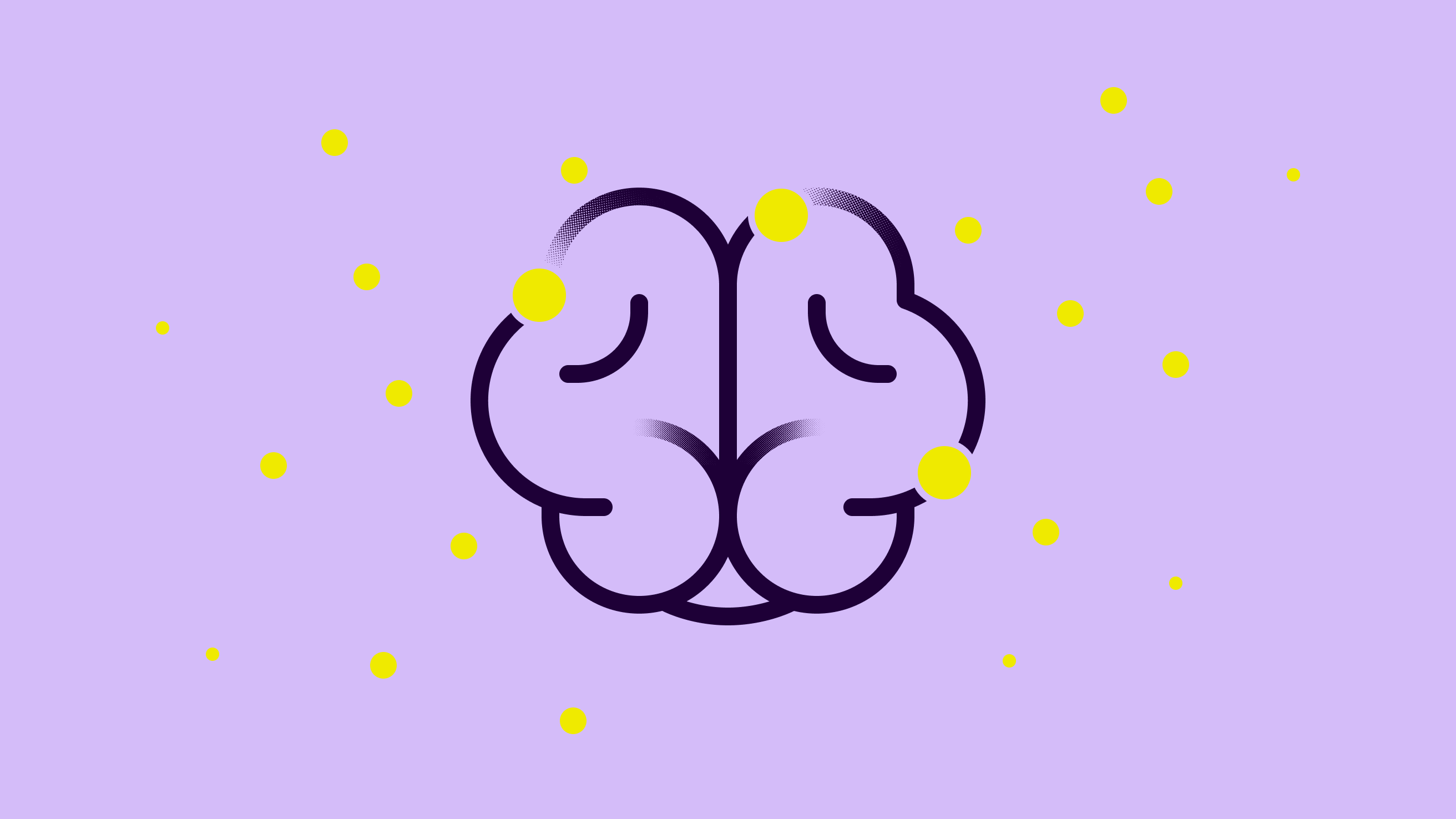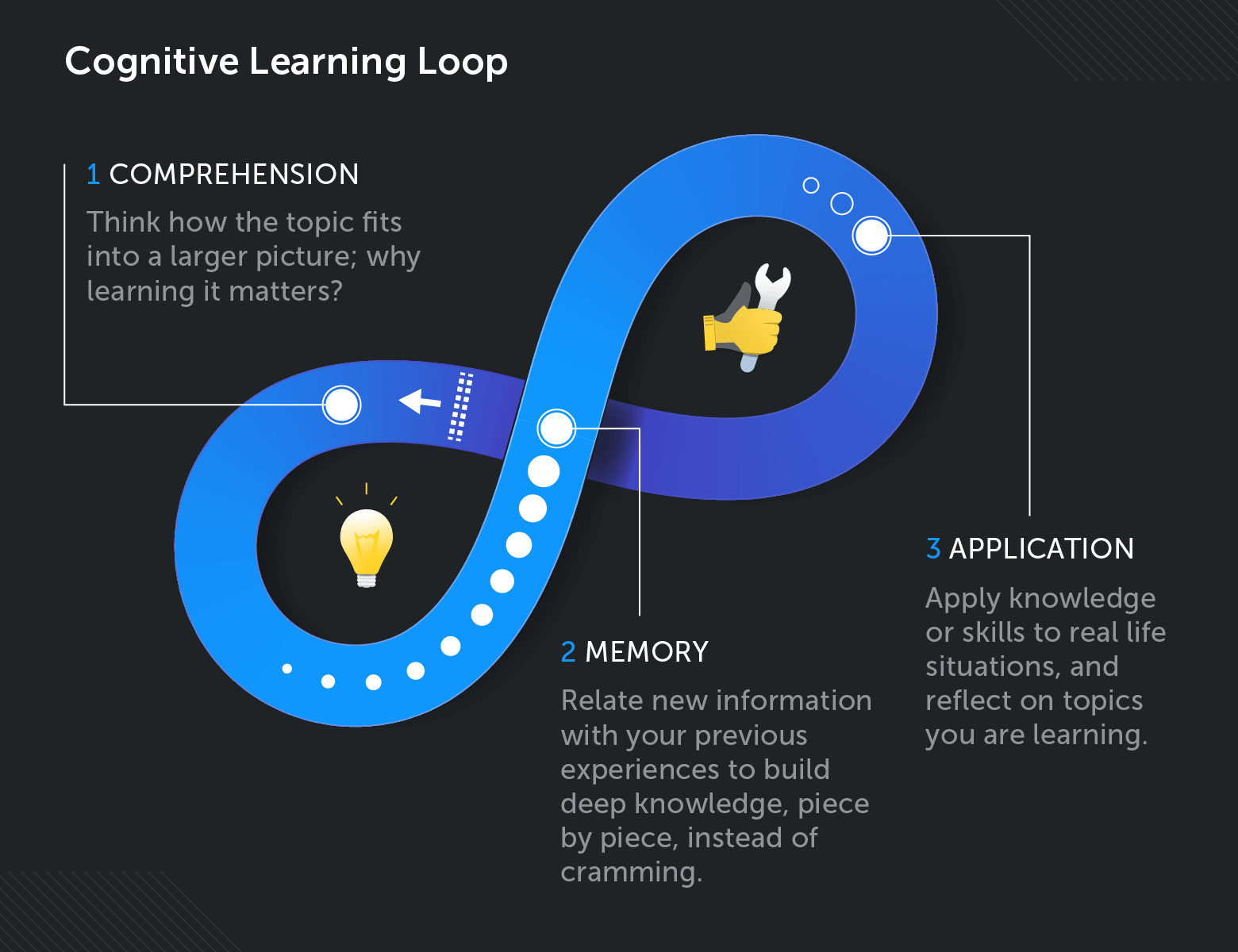Cognitive learning
Teaching cognitive learning to employees increases their expertise in handling more complex tasks. With examples and strategies for implementing this theory.

This guide gives you a clear understanding of how cognitive learning can positively impact your life in a corporate environment.
Training of cognitive learning to employees in organizations enhances and strengthens their expertise in handling more complex tasks.
Discover:
- What is cognitive learning?
- Components of cognitive learning
- Сognitive learning theories
- Benefits of cognitive learning
- Cognitive learning strategies
- Cognitive learning examples
What is cognitive learning?
Cognitive learning is an active style of learning that focuses on helping you learn how to maximize your brain’s potential. It makes it easier for you to connect new information with existing ideas hence deepening your memory and retention capacity.
The ability of the brain’s mental processes to absorb and retain information through experience, senses, and thought is known as cognition.
Employers need to expose employees to training on cognitive learning—an organization whose employees have strong cognitive skills is likely successful.
Well-trained and fully engaged employees are capable of learning quickly and being highly productive by handling multiple complex tasks without the necessity of a supervisor.
There is a young branch of psychology known as cognitive psychology. It is the study of one’s internal processes.
These are the things going on in your brain, such as thinking, attention, learning, problem-solving, perception, among others.
Components of cognitive learning
Traditional learning mainly focuses on memorization instead of trying to achieve mastery in a particular subject.
The following are fundamental aspects of cognitive learning:
1. Comprehension
For cognitive learning to be efficient and benefit you, understand the reason why you are learning a specific subject in the first place.
2. Memory
Cognitive learning discourages cramming of information, which is very ineffective in education. Having a deep understanding of a subject improves your ability to relate new knowledge with previous experiences or information.
3. Application
Cognitive learning strategies help you apply new information or skills in life situations. They encourage you as you continue to develop problem-solving skills.

Сognitive learning theories
Cognitive learning theory
Cognitive learning theory explains how internal and external factors influence an individual’s mental processes to supplement learning.
Delays and difficulties in learning are seen when cognitive processes are not working regularly. These processes are such as attention, observation, retrieval from long-term memory, and categorization.
Several researchers have made significant contributions to this theory. Jerome Bruner focused on how mental processes are linked to teaching.
Another researcher by the name Jean Piaget recognized that the environment plays a huge role and also focused on changes that take place in the internal cognitive structure. You can read more about Piaget’s theory of cognitive development in our previous article.
Today, cognitive learning theory is dominant in psychology. It is broken down into two categories.
Social cognitive theory
This theory helps us understand how people are influenced and their influence on the environment.
One of the major components of social cognitive theory is observational learning. It is the process of learning others’ desirable and undesirable behaviors through observation.
It is a quick way of acquiring information when you individually take action. A person who demonstrates behavior for another person is known as a model.
These may be real people such as teachers, our peers, and supervisors, or symbolic models, also known as fictional characters that influence an observer’s behavior.
Observational learning teaches people both positive and negative behaviors. For example, a manager within a company can teach the employees how they are supposed to behave ethically and be socially conscious when interacting and dealing with rude customers. Moreover, the manager can also train his/her employees on the different procedures that they can take in case of fire or other low probability hazardous scenarios.

Build a learning culture: a practical workbook for your organization
Upgrade your organization’s learning culture with clear, actionable strategies to address the challenges.
Download workbookCognitive behavioral theory
This theory mainly refers to our mental processes, such as our thoughts and interpretations of life events.
It explains how the thoughts, feelings, and behavior of a person interact with each other. Thoughts lead to particular emotions, which in turn lead to specific behavioral responses.
When we change our thoughts, we can change our emotions and then our behaviors. It also works in reverse where changing how we behave leads to changes in our feelings and, ultimately, our thoughts.
Let’s take an example of a developer who encounters a problem in a particular sphere and automatically believes that the task is difficult for him/her right away. The employee is automatically likely to have a negative attitude towards this particular task, and his performance will likely be poor.
Benefits of cognitive learning
The following are the major positive effects of cognitive learning:
1. Enhances learning
Cognitive learning theory enhances lifelong learning. Workers can build upon previous ideas and apply new concepts to already existing knowledge.
2. Boosts confidence
Employees become more confident in approaching tasks as they get a deeper understanding of new topics and learn new skills.
3. Enhances comprehension
Cognitive learning improves learners’ comprehension of acquiring new information. They can develop a deeper understanding of new learning materials.
4. Improves problem-solving skills
Cognitive learning equips employees with the skills they need to learn effectively. They are thereby able to develop problem-solving skills they can apply under challenging tasks.
5. Help learn new things faster
Through the experience of learning, the employee will be able to recycle and use the same learning methods that worked previously. This will help them learn new things a lot faster as they already know what works for them when it comes to obtaining new knowledge.
6. Teaches to form concept formation (think abstract)
Cognitive learning can also teach your employees to form a range of different concepts such as easily perceiving and interpreting information that could boost creativity and lead to innovations at the workplace.
Cognitive learning strategies
Several psychologists have shaped the concept of cognitive learning through research. They came up with theories and learning strategies that can be implemented in a corporate learning environment.
Learner-centered strategy
Jean Piaget termed learning as relating information to already existing knowledge. And each learner starts with their own knowledge and experience.
According to his theories, learning begins with the accumulation of some basic knowledge and advancing deeper into the field with time.
Piaget suggested three vital components of learning:
- Accommodation – taking new information into account by modifying what we already know.
- Assimilation – the arrangement of new knowledge inside our heads beside what we know.
- Equilibration – balancing what we already know with the new information that we are trying to acquire.
Each company should develop their training programs with a personalized learning approach to make it engaging for their employees to achieve better results.
To achieve that L&D professionals should focus on the following points:
- Develop and introduce their programs based on already existing knowledge.
- Provide more analogies to connect new knowledge with already existing knowledge.
- Divide learning materials into stages and maintain a logical flow of lessons taught.
- Provide examples or practical tasks that show how new information or principles can connect with previous knowledge, or enhance it.
- Encourage questions and comments from trainees.
Meaningful experiences strategy
David Ausubel made a clear distinction between meaningful learning and rote learning.
According to him, material that was closely related to what the learner knew was meaningful and always turned out to be effective.
Learners with relevant background knowledge find it easier to add new information.
During the training of learners in an organization:
- There should be an emphasis on the meaningfulness of each session to the task at hand.
- Background information on new material is essential.
- New information should be instilled in learners in a sequence to build on what is already understood.
Learning through discovery strategy
Jerome Bruner is a psychologist who built his theory on top of Piaget’s theory of cognitive development that was focusing on learning through discovery.
His theory identified three stages of cognitive representation which are enactive, iconic, and symbolic. Enactive defining the representation of knowledge through actions, iconic being the visual summarization of images, and symbolic which is the use of words and symbols to describe experiences.
Through his study of cognitive learning in children, he suggested that they should be allowed to discover information for themselves. He believed that learners review previously learned material even as they gain new knowledge.
His interpretation of Cognitive Learning Theory in a corporate environment can be put by:
- Allow employees to learn new skills and get new knowledge through new tasks and challenges.
- Challenge trainees to solve real-world problems your organization faces.
Personalized learning strategy
All of these strategies can be combined into one personalized learning approach. Each learner is unique and has their own experience, knowledge, and perception. Which can greatly influence the way they interpret and consume new information.
Creating learning experiences that fit each individual based on their own knowledge that is meaningful for their role which encourages them to discover new solutions can drive great results and improve their overall performance.
L&D professionals should try to organize a learning environment, to allow employees to learn at their own pace, and with a variety of learning opportunities.
A common practice in recent years to create personalized learning is the use of modern technologies: AI recommendations, learning paths, machine learning, natural language processing.
For example, a digital learning assistant has the capability to recognize what the skills of the employees are, what they have learned so far, and automatically suggest to them what they should learn next. The reason why such modern technology is essential in employee development, because it can offer information they need without them even anticipating the need for it. Overall, it’s a fantastic tool that can ensure better employee education and eventually drive greater performance.
Moreover, the company can save a significant amount of resources with a learning assistant as it can make your organization’s learning environment flawless even if scalability is required.
Furthermore, having the ultimate access to a range of company resources, no two employees need to learn or go through the same learning process as they can cherry-pick what they want to learn from.
Cognitive learning examples
Now you have a clear idea of what cognitive learning means. The following are various examples of cognitive learning.
1. Explicit learning
It happens when you intentionally seek knowledge to attempt and learn a new skill or process that may be vital to your work. It requires you to be attentive and take action to acquire knowledge.
An example of explicit learning would be undertaking an in-depth video editing course to understand the functionality of the software in order to be able to use it appropriately for the needs of your work.
2. Implicit learning
Sometimes you passively gain new knowledge and learn some new skills. It is known as implicit learning, where you are unaware of the entire process until you realize you have retained something new.
This type of learning may occur when you are working, talking, or going about your normal life.
Typing fast and without looking at your keyboard is one good example of implicit learning that comes automatically over time.
3. Meaningful learning
Meaningful learning is when you are capable of acquiring new information and relating it to past experiences.
This is because this cognitive learning approach teaches employees to build transferable problem-solving skills that can be applied in other areas.
An example of meaningful learning is when you work in procurement and decide to take an advanced course in your department to deepen your understanding of the subject.
4. Discovery learning
It happens when you actively seek new knowledge by researching new concepts, processes, and subjects.
For example, if someone is set the task to proofread a particular report and they need to make use of a specific tool such as Grammarly, by using this tool in hand with the manuals, this would cause them to learn the features and abilities of the tool through discovery.
5. Receptive learning
Lectures where you sit in groups and a speaker feeds the audience with information on a specific subject is an example of receptive learning. It requires the learner to be active by asking questions and taking down short notes.
During training in your workplace, this type of learning comes in handy where you get a deeper understanding of new information by being active and responsive to the speaker.
6. Non-associative learning (habituation and sensitization)
It is a type of learning that enables humans to adapt to something by facing it frequently.
When you get a new job at a factory where there are many machines making noise, it irritates for the first few days, but you later learn how to live with it. This is known as habituation.
Sensitization is the vice versa whereby your reaction towards something increases as you get frequent exposure towards it.
This type of learning happens in your typical situations in life and work. Working in an office teaches you to be more responsive to things like telephone calls.
7. Emotional learning
Developing emotional intelligence is crucial to help us maintain friendly relationships with friends at work and in life.
Emotional learning helps people learn how to take charge of their emotions and also understand others’.
An employer requires to have control over their emotions so as to handle customers and also their superiors in a courteous manner.
8. Experiential learning
Our experiences in life are our best lessons.
Your interactions with other people always teach you some precious life lessons. What you learn depends on how you interpret it.
For example, an intern learns by shadowing an experienced senior employer to gain experience. He acquires new skills that are relevant to his line of work.
9. Observation learning
One of the significant components of the social cognitive theory is observational learning.
It is handy among employees since it mainly involves imitation of skills from colleagues and superiors.
Observing your friends or work colleagues is an efficient way to learn a new skill.
Your successful manager at work can help you improve your leadership qualities as you embrace and practice his habits.
10. Cooperative and collaborative learning
Working and learning in groups is encouraged in many institutions.
Cooperative learning helps bring out one’s best skills and deepens the collaboration between a group of people (read more about collaborative learning).
However, for an individual to learn this way, he/she has to be an active and equal participant and interact with fellow group members.
Some companies select individuals to train on new strategies that improve the success of an organization. The trained employees are then encouraged to pass on this knowledge to their team members.
The types of cognitive learning above are vital in using your brain’s features as much as possible. They make it easier for you to acquire new skills and knowledge in life.

Build a learning culture: a practical workbook for your organization
Upgrade your organization’s learning culture with clear, actionable strategies to address the challenges.
Download workbook



